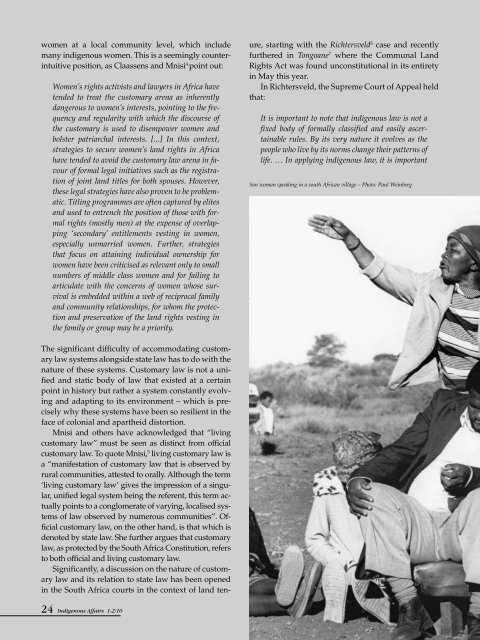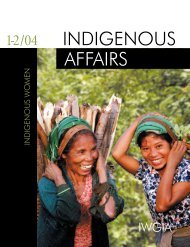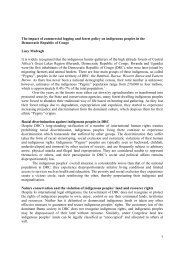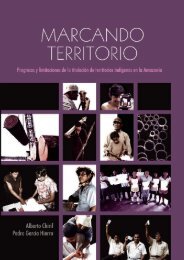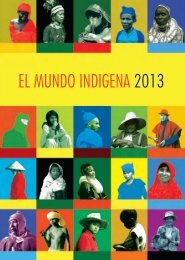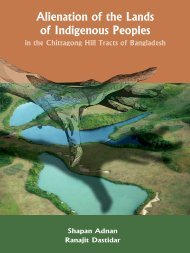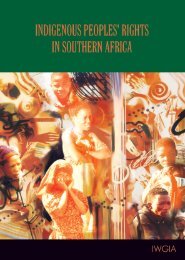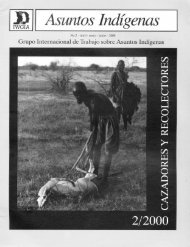Download (pdf) - iwgia
Download (pdf) - iwgia
Download (pdf) - iwgia
You also want an ePaper? Increase the reach of your titles
YUMPU automatically turns print PDFs into web optimized ePapers that Google loves.
women at a local community level, which include<br />
many indigenous women. This is a seemingly counterintuitive<br />
position, as Claassens and Mnisi 4 point out:<br />
Women’s rights activists and lawyers in Africa have<br />
tended to treat the customary arena as inherently<br />
dangerous to women’s interests, pointing to the frequency<br />
and regularity with which the discourse of<br />
the customary is used to disempower women and<br />
bolster patriarchal interests. [...] In this context,<br />
strategies to secure women’s land rights in Africa<br />
have tended to avoid the customary law arena in favour<br />
of formal legal initiatives such as the registration<br />
of joint land titles for both spouses. However,<br />
these legal strategies have also proven to be problematic.<br />
Titling programmes are often captured by elites<br />
and used to entrench the position of those with formal<br />
rights (mostly men) at the expense of overlapping<br />
‘secondary’ entitlements vesting in women,<br />
especially unmarried women. Further, strategies<br />
that focus on attaining individual ownership for<br />
women have been criticised as relevant only to small<br />
numbers of middle class women and for failing to<br />
articulate with the concerns of women whose survival<br />
is embedded within a web of reciprocal family<br />
and community relationships, for whom the protection<br />
and preservation of the land rights vesting in<br />
the family or group may be a priority.<br />
The significant difficulty of accommodating customary<br />
law systems alongside state law has to do with the<br />
nature of these systems. Customary law is not a unified<br />
and static body of law that existed at a certain<br />
point in history but rather a system constantly evolving<br />
and adapting to its environment – which is precisely<br />
why these systems have been so resilient in the<br />
face of colonial and apartheid distortion.<br />
Mnisi and others have acknowledged that “living<br />
customary law” must be seen as distinct from official<br />
customary law. To quote Mnisi, 5 living customary law is<br />
a “manifestation of customary law that is observed by<br />
rural communities, attested to orally. Although the term<br />
‘living customary law’ gives the impression of a singular,<br />
unified legal system being the referent, this term actually<br />
points to a conglomerate of varying, localised systems<br />
of law observed by numerous communities”. Official<br />
customary law, on the other hand, is that which is<br />
denoted by state law. She further argues that customary<br />
law, as protected by the South Africa Constitution, refers<br />
to both official and living customary law.<br />
Significantly, a discussion on the nature of customary<br />
law and its relation to state law has been opened<br />
in the South Africa courts in the context of land tenure,<br />
starting with the Richtersveld 6 case and recently<br />
furthered in Tongoane 7 where the Communal Land<br />
Rights Act was found unconstitutional in its entirety<br />
in May this year.<br />
In Richtersveld, the Supreme Court of Appeal held<br />
that:<br />
It is important to note that indigenous law is not a<br />
fixed body of formally classified and easily ascertainable<br />
rules. By its very nature it evolves as the<br />
people who live by its norms change their patterns of<br />
life. … In applying indigenous law, it is important<br />
San woman speaking in a south African village – Photo: Paul Weinberg<br />
24 Indigenous Affairs 1-2/10


